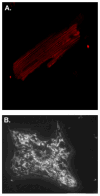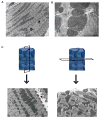Morphological dynamics of mitochondria--a special emphasis on cardiac muscle cells
- PMID: 19281816
- PMCID: PMC2995918
- DOI: 10.1016/j.yjmcc.2009.02.023
Morphological dynamics of mitochondria--a special emphasis on cardiac muscle cells
Abstract
Mitochondria play a critical role in cellular energy metabolism, Ca(2+) homeostasis, reactive oxygen species generation, apoptosis, aging, and development. Many recent publications have shown that a continuous balance of fusion and fission of these organelles is important in maintaining their proper function. Therefore, there is a steep correlation between the form and function of mitochondria. Many major proteins involved in mitochondrial fusion and fission have been identified in different cell types, including heart. However, the functional role of mitochondrial dynamics in the heart remains, for the most part, unexplored. In this review we will cover the recent field of mitochondrial dynamics and its physiological and pathological implications, with a particular emphasis on the experimental and theoretical basis of mitochondrial dynamics in the heart.
Figures





References
-
- Scheffler IE. Mitochondria. 1. Wiley-Liss; 1999.
-
- Detmer SA, Chan DC. Functions and dysfunctions of mitochondrial dynamics. Nat Rev Mol Cell Biol. 2007 Nov;8(11):870–9. - PubMed
-
- Szabadkai G, Simoni AM, Bianchi K, De Stefani D, Leo S, Wieckowski MR, et al. Mitochondrial dynamics and Ca2+ signaling. Biochim Biophys Acta. 2006 May–Jun;1763(5–6):442–9. - PubMed
Publication types
MeSH terms
Grants and funding
LinkOut - more resources
Full Text Sources
Miscellaneous

